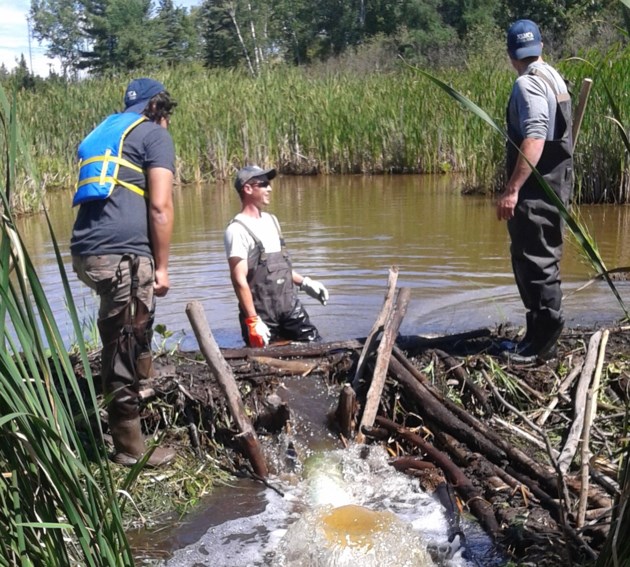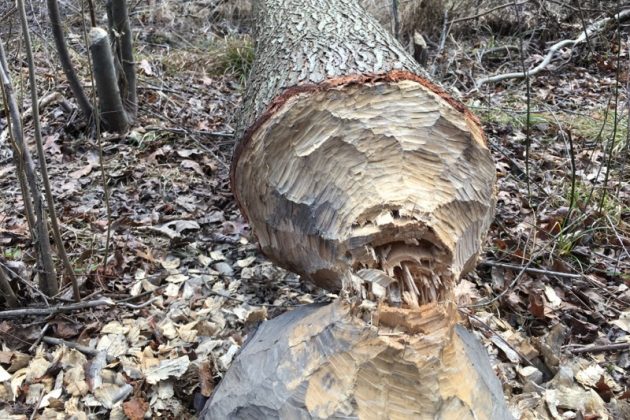There is a lot of beaver news to catch up on this morning. I got behind on earthday and let our usual beaver-ticker slide. It’s monday and I think we should start with the good news and grim our way down the ladder from there, okay? (And yes I know that ‘grim’ isn’t a verb, but it just seems right today.)
Long time readers of this website might remember that a while ago Washington passed a ‘beaver bill’ that allowed them to relocate problem beavers in the Eastern (driest) part of the state. (Our beaver friends Joe Cannon and Amanda Parish of the Lands Council worked on that.) It was a pretty big deal at the time and was a struggle to pass. Well, on Thursday the governor signed into law a change stating that beavers could be relocated in WESTERN Washington as well.

This is Chompski, a beaver relocated in Bodie Creek outside Wauconda, Washington in 2012. (Chandra Hutsel / Courtesy of state Rep. Joel Kretz)
Western Washington can have relocated beavers
Western Washington beavers who are trapped by the state Department of Fish and Wildlife can be relocated to a more opportune location west of the Cascades, a bill signed into law by Gov. Jay Inslee Thursday says.
The department has had a program to relocate nuisance beavers it traps in Eastern Washington for several years, with the restriction that they can’t be shipped over the mountains to the “wet side” of the state. The program started when Rep. Joel Kretz, R-Wauconda, thought some of the toothy rodents that the department was already trapping might be sent to land owners that were trying to improve their water tables by impounding creeks or streams.
This year, some Western Washington landowners decided they wanted to try it, too. The original bill took Kretz several tries to make it through the Legislature. This bill passed the House 98-0, and the Senate 45-1.
It was 2012 when the Eastern law finally passed – years after it had been promoted and voted down many times. In fact in 2005 a bill allowing it was vetoed by the governor of the state. What a difference 12 years makes, eh? I guess the state is finally recognizing the good things that beavers do for fish, water and wildlife. Now they just need to learn to leave the beavers where they are and change the people instead – making them use the tools that will let them to coexist.
Another dozen years maybe?
Meanwhile in Canada the “Beaver Whisperer” is teaching folks how to manage beaver conflicts using a ‘baffler’. Mostly good news, although we’re not thrilled by his protege’s statement that beavers damage water quality.
Learn how to manage beavers on your property from the ‘Beaver Whisperer’
Learn how to manage beavers and create a peaceful co-existence on May 11 at the Beaver Management Workshop, hosted by the North Bay-Mattawa Conservation Authority (NBMCA) and Friends of Laurier Woods.

“Beavers can be a benefit and a bur
den,” explains Troy Storms, NBMCA’s Supervisor, Field Operations.
“They help maintain important wetland ecosystems. They create habitat for themselves, as well as several other species. But they can damage vegetation, farmland, municipal infrastructure and water quality,” he added.
This workshop includes a morning presentation by “beaver whisperer” Michel Leclair, followed by an afternoon field trip to Laurier Woods Conservation Area to see a “beaver baffle” in action.
Two steps forward one step back. I’m pretty sure that even if beavers are important to other species damaging water quality is kind of deal-breaker. That’s what we call very bad advertising. I’m sure he’s referring to the bogus concern that they cause ‘beaver fever’ which we all know MUST be true because it rhymes. I wish someone was on hand to talk about how much they IMPROVE water quality or how their dams act as a filter to remove toxins and nitrates from the water.
Is it too much to ask?
Finally a very ugly story from North Carolina where they believe they proudly have discovered that beaver dams can be destroyed with a machete.
Busting beaver dams solves flooding problem near Linden
 LINDEN — Flooding across from a neighborhood near Lake Teresa has greatly diminished after members of the community and other helpers tore down beaver dams nearby. Bob Hathcock, who lives on Canal Street, said the swamp that had formed in a wooded area between the street and a field off Lane Road near Linden has gone down.
LINDEN — Flooding across from a neighborhood near Lake Teresa has greatly diminished after members of the community and other helpers tore down beaver dams nearby. Bob Hathcock, who lives on Canal Street, said the swamp that had formed in a wooded area between the street and a field off Lane Road near Linden has gone down.
“I’d say it’s down two feet and still draining,” he said.
He described the work as a community effort that involved four neighborhood residents and three people who live elsewhere. “We got out there with axes, shovels and machetes, and started busting things up,” he said. “The people kind of enjoyed it.”
Hathcock said the destruction of three dams, including one that was about 200 feet wide, did not reduce the swamp near the neighborhood. When a fourth was tore down, the water started receding. It went down even more after a fifth dam was removed.
“Everything is flowing out now,” he said. “We are so relieved.” Hathcock said eight beavers have been trapped. Some weighed more than 50 pounds each, he said.
“We’ve still got traps out there,” he said. One person managed to catch a beaver the day after he put out a trap, Hathcock said. “He was like a kid at Christmas trapping that beaver,” he said.
Hathcock said several companies offered to deal with the problem, but were going to charge up to thousands of dollars. The USDA charged the residents $25, he said.
How much do I hate this article? Let me count the ways.
So Jimbob and Billybud got all their axes and pitchforks and ripped out 5 (five!) beaver dams to make the water flow again. (Just because he lives on Canal street, Bob never expected there to be WATER on it.) Remember that this is a state we gave countless FEMA dollars in drought relief a couple years ago, but never mind, because who needs to save water anyway? Now it’s free like aMurica! Never mind the dying fish, frogs or the wood duck hatchlings whose nests are now too far from the water to make the jump safely. What matters is that 8 beavers are dead, the folk had fun destroying their wetlans and someone celebrated Christmas early.
I am curious though, if folks ripped out the dams and trapped the beavers themselves, what exactly the USDA was charging 25 dollars for?















































